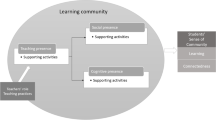Abstract
The purpose of this study was to analyze a five-week graduate-level education course taught entirely at a distance via the Internet using the Blackboard.comSM e-learning system, with emphasis on exploring the dynamics of sense of classroom community. Subjects were 20 adult learners, evenly divided between males and females, who were administered the sense of classroom community index at the beginning and end of the course in order to measure classroom community. Findings indicated that on-line learners took advantage of the “learn anytime” characteristics of the Internet by accessing the course seven days per week, 24 hours per day. Sense of classroom community grew significantly during the course. Females manifested a stronger sense of community than their male counterparts both at the start and end of the course. Additionally, female students exhibited a mostly connected communication pattern while the communication pattern of males was mostly independent.
Similar content being viewed by others
References
Abrahamson, C.E. (1998). Issues in interactive communication in distance education.College Student Journal, 32(1), 33–43.
Baxter-Magolda, M.B. (1992).Knowing and reasoning in college: Gender-related patterns in students' intellectual development. San Francisco: Jossey-Bass.
Belenky, M., Clinchy, B., Goldberger, N., & Tarule, J. (1986).Women's ways of knowing. New York: Basic Books.
Blum, K.D. (1999). Gender differences in asynchronous learning in higher education: Learning styles, participation barriers and communication patterns.Journal of Asynchronous Learning Networks,1(3). Retrieved April 18, 2001, from the World Wide Web:http://http://www.aln.org/alnweb/journal/Vol3_issue1/blum.htm
Brown, K.M. (1996). The role of internal and external factors in the discontinuation of off-campus students.Distance Education, 17(1), 44–71.
Bruffee, K.A. (1993).Collaborative learning: Higher education, interdependence, and the authority of knowledge. Baltimore: John Hopkins University Press.
Bryk, A.S., & Driscoll, M.E. (1988).The high school as community: Contextual influences and consequences for students and teachers Madison, WI: National Center on Effective Secondary Schools, University of Wisconsin. (ERIC Document Reproduction Service No. ED 302 539)
Bull, K.S., Kimball, S.L., & Stansberry, S. (1998).Developing interaction in computer mediated learning. (ERIC Document Reproduction Service No. ED 417 902)
Comeaux, P. (1995). The impact of an interactive distance learning network on classroom communion.Communication Education, 44, 355–361.
Cutler, R.H. (1996). Technologies, relations and selves. In L. Strate, R. Jacobson, & S.B. Gibson (Eds.),Communication and cyberspace: Social interaction in an electronic environment (pp. 317–333). Cresskill, NJ: Hampton Press.
Dede, C. (1996). The evolution of distance education: Emerging technologies and distributed learning.American Journal of Distance Education, 10(2), 4–36.
Etzioni, A. (1993).The spirit of community: Rights, responsibility, and the communitarian agenda. New York: Crown.
Goodlad, J.L. (1996). Democracy, education, and community. In R. Soder (Ed.),Democracy, education, and the schools (pp. 87–96). New York: Jossey-Bass.
Hare, A.P., & Davies, M.F. (1994). Social interaction. In A.P. Hare, H.H. Blumberg, M.F. Davies, & M.V. Kent (Eds.),Small group research: A handbook (pp. 169–193). Norwood, NJ: Ablex.
Herring, S. (1996). Posting in a different voice. In C. Ess (Ed.)Philosophical perspectives on computer-mediated communication (pp. 115–145) New York: SUNY.
Hill, J.L. (1996). Psychological sense of community: Suggestions for future research.Journal of Community Psychology, 24(4), 431–438.
Hiltz, S.R. (1998).Collaborative learning in asynchronous learning networks: Building learning communities. Invited address at the WEB98 Conference, Orlando, Florida. Retrieved April 18, 2001, from the World Wide Web: http://eies.njit.edu/hiltz/collaborative_learning_in_asynch.htm
McMahon, T.A. (1997).From isolation to interaction? Network-based professional development and teacher professional communication. Paper presented at the annual meeting of the American Educational Research Association, Chicago, Il. (ERIC Document Reproduction Service No. ED 408 257)
McMillan, D.W. (1996). Sense of community.Journal of Community Psychology, 24(4), 315–325.
McMillan, D.W., & Chavis, D.M. (1986). Sense of community: A definition and theory.Journal of Community Psychology, 14(1), 6–23.
Moore, M.G. (1972). Learner autonomy: The second dimension of independent learning.Convergence 5 (2), 76–88.
Palloff, R.M., & Pratt, K. (1999).Building learning communities in cyberspace. San Francisco: Jossey-Bass Publishers.
Preece, J. (2000).Online communities: Designing usability, supporting sociability. New York: Wiley & Sons.
Putnam, R.D. (January 1995). Bowling alone: America's declining social capital.Journal of Democracy, 6, 65–78.
Reingold, H. (1991).The virtual community. New York: Summit.
Rice, R.E., & Love, G. (1987). Electronic emotion: Socioemotional content in a computer-mediated network.Communication Research, 14, 85–108.
Rovai, A.P., & Lucking, R.A. (2000).Measuring sense of classroom community. Manuscript submitted for publication.
Vrasidas, C., & McIsaac, M.S. (1999). Factors influencing interaction in an online course.American Journal of Distance Education, 13 (3), 22–36.
Vygotsky, L. (1986).Thought and language. Cambridge, MA: MIT Press.
Wegerif, R. (1998). The social dimension of asynchronous learning networks.Journal of Asynchronous Learning Networks, 2(1), 34–49.
Wellman, B. (1999). The network community: An introduction to networks in the global village. In Wellman, B. (Ed.)Networks in the global village. Boulder, CO: Westview Press.
Wellman, B., & Gulia, M. (1999). The network basis of social support: A network is more than the sum of its ties. In B. Wellman (Ed.),Networks in the global village (pp. 83118) Boulder, CO: Westview Press.
Author information
Authors and Affiliations
Rights and permissions
About this article
Cite this article
Rovai, A.P. Building classroom community at a distance: A case study. ETR&D 49, 33–48 (2001). https://doi.org/10.1007/BF02504946
Issue Date:
DOI: https://doi.org/10.1007/BF02504946




